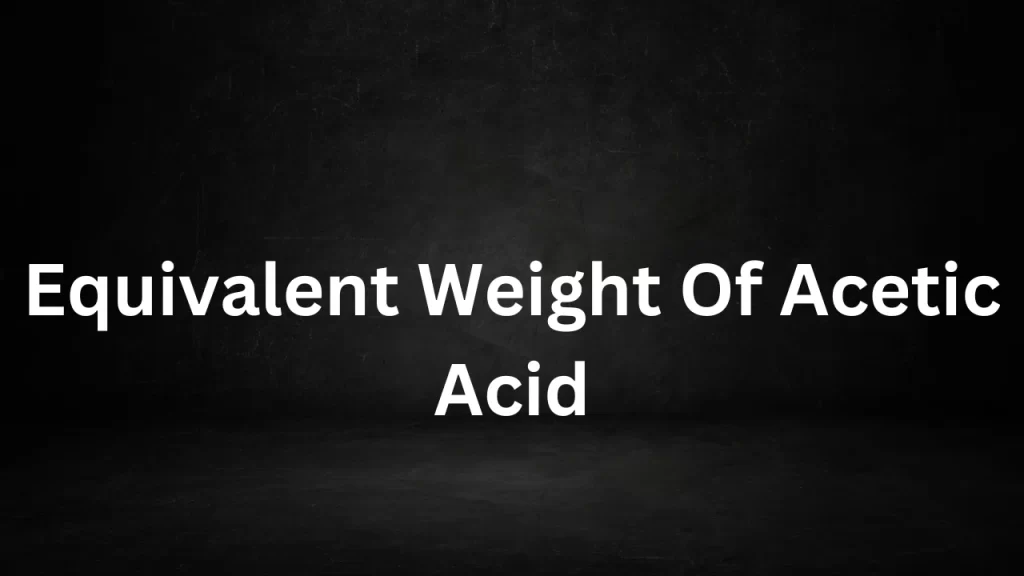Category: Class 11
Difference Between Kinematic And Dynamic Viscosity
Difference Between Kinematic And Dynamic Viscosity: Viscosity is a fundamental property of fluids that characterizes their resistance to flow. It plays a crucial role in various applications, from engineering and physics to everyday life.
Two essential parameters used to describe viscosity are kinematic viscosity and dynamic viscosity. In this article, we will explore the differences between these two types of viscosity and their significance in different fields.

Difference Between Kinematic And Dynamic Viscosity
Kinematic Viscosity
Kinematic viscosity Kinematic viscosity quantifies how a fluid resists flowing under the influence of gravity. This is calculated by dividing the fluid’s dynamic viscosity, typically represented as μ, by its density, denoted as ρ. The formula for kinematic viscosity (ν) is as follows:
ν = μ / ρ
Here, ν represents kinematic viscosity, μ represents dynamic viscosity, and ρ represents the density of the fluid.
In the International System of Units (SI), kinematic viscosity is typically denoted in units of square meters per second (m²/s). In other systems of measurement, it can be expressed in units like centistokes (cSt) or square feet per second (ft²/s).
Dynamic Viscosity
Dynamic viscosity, often simply referred to as viscosity, measures a fluid’s internal resistance to shear or flow when subjected to an external force. It quantifies the force required to move one layer of fluid in relation to another layer. The unit of dynamic viscosity in SI is the pascal-second (Pa·s), which is equivalent to one kilogram per meter per second (kg/(m·s)).
Newton’s law of viscosity describes the connection between dynamic viscosity (μ) and shear stress (τ) as follows:
τ = μ * (du/dy)
In this equation, τ represents shear stress, μ represents dynamic viscosity, du/dy represents the velocity gradient (change in velocity with respect to distance), and the equation essentially relates the applied force (shear stress) to the rate of deformation (velocity gradient) in the fluid.
Key Differences
1. Definition:
- Kinematic Viscosity: It is the ratio of dynamic viscosity to density and is primarily concerned with the flow of fluids under the influence of gravity.
- Dynamic Viscosity: It directly measures a fluid’s resistance to shear or flow and quantifies the internal friction within the fluid.
2. Units
- Kinematic Viscosity: Usually, it is denominated in units of square meters per second (m²/s) within the SI system.
- Dynamic Viscosity: It is articulated in units of pascal-seconds (Pa·s) in SI units.
3. Applications
- Kinematic Viscosity: It is commonly used in applications involving fluids that are affected by gravity, such as in the analysis of fluid flow in pipes or open channels.
- Dynamic Viscosity: It is crucial in a wide range of engineering and scientific applications, including the design of pumps, the study of fluid dynamics, and the analysis of materials’ rheological properties.
4. Symbol
- Kinematic Viscosity: It is represented by the symbol ν.
- Dynamic Viscosity: It is represented by the symbol μ.
Practical Significance
Understanding the difference between kinematic and dynamic viscosity is essential for various practical applications:
- In hydraulic engineering, kinematic viscosity helps determine the flow characteristics of liquids in open channels, pipes, and rivers.
- In automotive and aerospace industries, dynamic viscosity plays a crucial role in the design and optimization of lubricants and fuels to ensure efficient engine performance.
- In the pharmaceutical and food processing sectors, dynamic viscosity is utilized to assess the flow properties of substances like syrups, creams, and emulsions.
- In the realm of materials science, both kinematic and dynamic viscosity find application in the investigation of the rheological characteristics of materials, encompassing polymers, paints, and suspensions.
In summary, both kinematic and dynamic viscosity measure a fluid’s resistance to flow, but they serve distinct roles in the fields of science and engineering. Kinematic viscosity is especially pertinent in situations affected by gravitational forces, whereas dynamic viscosity holds fundamental significance across a wide range of applications involving fluid behavior, flow, and deformation. A firm grasp of these concepts is essential for designing systems, predicting behavior, and resolving real-world engineering challenges.
Read More
- Sodium Acetate Molecular Weight
- Sodium Bicarbonate Molecular Weight
- Organic And Inorganic Chemistry
- Equivalent Weight Of Acetic Acid
- Law Of Conservation Of Mass
Frequently Asked Questions (FAQs) On Difference Between Kinematic And Dynamic Viscosity
1. What is the primary difference between kinematic and dynamic viscosity?
- Kinematic Viscosity: Kinematic viscosity is the ratio of dynamic viscosity to density and is concerned with fluid flow under the influence of gravity.
- Dynamic Viscosity: Dynamic viscosity measures a fluid’s internal resistance to shear or flow and quantifies the internal friction within the fluid.
2. How are kinematic and dynamic viscosity calculated?
- Kinematic Viscosity: The calculation involves dividing the dynamic viscosity (μ) of the fluid by its density (ρ), expressed as ν = μ / ρ.
- Dynamic Viscosity: Dynamic viscosity is commonly directly measured and is often expressed in units such as pascal-seconds (Pa·s) within the SI system.
3. In which industries or fields are these viscosity parameters crucial?
- Kinematic Viscosity: It is important in hydraulic engineering for analyzing flows in channels and pipes and in geophysics for understanding the movement of fluids in natural systems.
- Dynamic Viscosity: Dynamic viscosity holds a pivotal role in various industries, including automotive, aerospace, pharmaceuticals, food processing, and materials science. It aids in the optimization of fluid properties and provides insights into material behavior.
4. Could you offer an instance where kinematic viscosity is applicable?
Example: Kinematic viscosity plays a pivotal role in assessing the flow attributes of oil within pipelines or rivers, aiding engineers in the creation of efficient transportation and distribution systems.
5. What symbols are used to represent kinematic and dynamic viscosity?
Kinematic Viscosity: Kinematic viscosity is represented by the symbol ν.
Dynamic Viscosity: Dynamic viscosity is denoted by the symbol μ.
Sodium Acetate Molecular Weight
Sodium Acetate Molecular Weight: Sodium acetate, represented by the chemical formula NaCH₃COO, is a compound that plays a pivotal role in various scientific, industrial, and everyday applications.
One of the fundamental aspects of any chemical compound is its molecular weight, as it provides insights into its properties, behavior, and applications. In this comprehensive article, we will delve deep into the molecular weight of sodium acetate, exploring its significance, its wide-ranging uses in different domains, its chemical structure, and the processes involved in its production.

Sodium Acetate Molecular Weight
Introduction to Sodium Acetate
Chemical Formula and Structure
Before we delve into the molecular weight of sodium acetate, let’s familiarize ourselves with its chemical structure and composition. Sodium acetate is a sodium salt of acetic acid, a simple carboxylic acid. Its chemical formula is NaCH₃COO. This formula reveals that it consists of sodium ions (Na⁺) and acetate ions (CH₃COO⁻). The acetate ion itself comprises a methyl group (CH₃-) and a carboxylate group (-COO⁻).
The structural representation of sodium acetate showcases its arrangement at the molecular level, with sodium cations (Na⁺) surrounded by acetate anions (CH₃COO⁻):
Physical Properties
Sodium acetate is most commonly found in the form of white crystalline powder or as trihydrate crystals. The trihydrate form of sodium acetate contains three molecules of water (H₂O) associated with each formula unit, which is represented as NaCH₃COO·3H₂O. This trihydrate form is often encountered due to its stability and ease of crystallization.
Key Physical Properties:
- Appearance: White crystalline powder or trihydrate crystals.
- Solubility: Soluble in water and slightly soluble in ethanol.
- Melting Point: The anhydrous form has a melting point of approximately 324°C (615°F), while the trihydrate form melts at around 58°C (136°F).
- Odor: Odorless.
Now that we have a foundational understanding of sodium acetate, let’s dive into the fascinating world of molecular weight and its significance.
Molecular Weight: What Does It Mean?
Molecular weight, also known as molecular mass or molar mass, is a fundamental concept in chemistry. It represents the mass of a molecule expressed in atomic mass units (amu) or unified atomic mass units (u). Molecular weight is essentially a measure of the sum of the atomic masses of all the atoms present in a molecule.
In the case of sodium acetate (NaCH₃COO), its molecular weight is determined by adding up the atomic masses of all the individual atoms that constitute it. This value is not only useful for understanding the compound’s chemical properties but also plays a crucial role in various practical applications.
Calculating the Molecular Weight of Sodium Acetate
To calculate the molecular weight of sodium acetate (NaCH₃COO), we need to consider the atomic masses of its constituent elements:
- Atomic mass of sodium (Na) ≈ 22.99 amu (atomic mass units)
- Atomic mass of carbon (C) ≈ 12.01 amu
- Atomic mass of hydrogen (H) ≈ 1.01 amu
- Atomic mass of oxygen (O) ≈ 16.00 amu
Now, let’s calculate the molecular mass of sodium acetate:
Molecular Mass of NaCH₃COO = (1 × Atomic mass of Na) + (2 × Atomic mass of C) + (3 × Atomic mass of H) + (2 × Atomic mass of O)
The Molecular Mass of NaCH₃COO = (1 × 22.99 amu) + (2 × 12.01 amu) + (3 × 1.01 amu) + (2 × 16.00 amu)
Molecular Mass of NaCH₃COO ≈ 82.03 amuTherefore, the molecular weight of sodium acetate (NaCH₃COO) is approximately 82.03 atomic mass units (amu).
Significance of Molecular Weight
Now that we have determined the molecular weight of sodium acetate, it’s essential to understand why this value is significant and how it is applied in various fields and industries.
1. Chemical Reactions and Stoichiometry
Molecular weight plays a crucial role in chemical reactions and stoichiometry, which is the study of the quantitative relationships between reactants and products in chemical reactions. Here’s how it is relevant:
Balancing Equations: When balancing chemical equations, the molecular weight of each compound involved is essential for ensuring that the equation obeys the law of conservation of mass.
Determining Reaction Yield: Molecular weight helps calculate the theoretical yield of a product in a chemical reaction, allowing chemists to assess reaction efficiency.
2. Food Industry
In the food industry, sodium acetate is used as a food additive for various purposes, including as a preservative, acidity regulator, and flavor enhancer. The molecular weight of sodium acetate is relevant in food processing for several reasons:
- Dosage Control: Understanding the molecular weight is crucial for accurately determining the appropriate amount of sodium acetate to be added to food products.
- Preservation: As a preservative, sodium acetate helps extend the shelf life of certain foods, and precise measurements are essential to achieve the desired preservation effect.
- Flavor Enhancement: Sodium acetate contributes to enhancing the flavor of foods, and its correct application relies on understanding its molecular mass.
3. Pharmaceuticals
In the pharmaceutical industry, precise measurements are critical for formulating medications, and the molecular weight of each component in a drug plays a vital role. Sodium acetate is employed in diverse medicinal formulations, where its molecular weight is crucial for precise dosage calculations and accurate preparation of medicinal solutions.
4. Heating Pads
One of the intriguing applications of sodium acetate is in reusable heating pads. These pads contain a supersaturated solution of sodium acetate trihydrate, which can be triggered to crystallize and release heat when flexed or clicked. The molecular weight of sodium acetate is crucial in understanding the heat storage and release properties of these pads, making them a convenient and eco-friendly heat source.
5. Laboratory Use
In laboratories, sodium acetate serves as a buffer solution, controlling pH in a broad spectrum of chemical reactions. Its mole mass is a fundamental parameter in laboratory research and experimentation. Buffer solutions are essential for maintaining stable pH conditions in experiments involving sensitive reactions.
6. Chemical Industry
Sodium acetate finds applications in the chemical industry for the synthesis of various organic compounds. Its mole mass is significant for precise measurements and reactions. It serves as a versatile reagent in chemical processes.
7. Textile Industry
In the textile industry, sodium acetate is used in dyeing processes. The mole weight of sodium acetate is essential in ensuring the correct composition of dyeing solutions. It helps achieve desired dyeing effects on textiles.
8. Deicing Agent
Sodium acetate serves as an eco-friendly substitute for conventional deicing salts. Its molecular mass is relevant in understanding its ice-melting properties. When applied to icy surfaces, sodium acetate helps lower the freezing point of water, effectively melting ice and snow.
Conclusion
In conclusion, sodium acetate, with its mole weight of approximately 82.03 atomic mass units (amu), is a versatile compound with widespread applications across various industries and scientific domains. Whether it’s preserving food, formulating pharmaceuticals, providing heat in heating pads, or serving as a buffer solution in laboratories, sodium acetate plays a crucial role in enhancing our daily lives and advancing scientific and industrial processes. Its molecular mass serves as a fundamental parameter in these applications, ensuring accurate measurements and precise outcomes.
Read More
- Sodium Bicarbonate Molecular Weight
- Organic And Inorganic Chemistry
- Equivalent Weight Of Acetic Acid
- Law Of Conservation Of Mass
- Drops Bubbles And Capillary Rise
Frequently Asked Questions (FAQs) On Sodium Acetate Molecular Weight
1. What is the molecular weight of sodium acetate?
The mole weight of sodium acetate (NaCH₃COO) is approximately 82.03 atomic mass units (amu).
2. Why is the molecular weight of sodium acetate important?
The mole weight of sodium acetate is crucial for various applications, including dosing in pharmaceuticals, food processing, chemical reactions, and stoichiometry. It helps in accurately determining the quantity of sodium acetate required for specific purposes.
3. How is the molecular weight of sodium acetate determined?
Calculating the molecular weight of sodium acetate involves summing the atomic masses of its elements: sodium (Na), carbon (C), hydrogen (H), and oxygen (O). The formula is as follows:
Molecular Weight of NaCH₃COO = (1 × Atomic mass of Na) + (2 × Atomic mass of C) + (3 × Atomic mass of H) + (2 × Atomic mass of O)
4. In what industries or fields is the molecular weight of sodium acetate relevant?
The mole weight of sodium acetate is relevant in various industries and fields, including:
- Chemical industry
- Food processing
- Pharmaceuticals
- Heating pad manufacturing
- Laboratory research
- Textile industry
- Deicing applications
- Environmental science
5. Is sodium acetate suitable as a food additive?
Yes, sodium acetate is used as a food additive in the food industry. It serves various purposes, including preserving food, regulating acidity, and enhancing flavors. Its molecular weight is relevant for precise dosing in food processing.
Sodium Bicarbonate Molecular Weight
Sodium Bicarbonate Molecular Weight: Sodium bicarbonate, commonly known as baking soda, is a household staple with a wide range of applications, from baking to cleaning and beyond.
In this article, we delve into the molecular weight of sodium bicarbonate and explore its significance in various aspects of chemistry and everyday life.

Sodium Bicarbonate Molecular Weight
Understanding Sodium Bicarbonate (NaHCO3)
Sodium bicarbonate is a chemical compound with the mole formula NaHCO3. It consists of sodium (Na), hydrogen (H), carbon (C), and oxygen (O) atoms. This white crystalline powder is odorless and has a slightly salty, alkaline taste. Sodium bicarbonate, commonly recognized as baking soda, is most famous for its function as a leavening agent in baking. In this role, it reacts with acidic components, generating carbon dioxide gas, which results in dough expansion and the production of light and fluffy baked goods.
Molecular Weight of Sodium Bicarbonate
The molecular weight of sodium bicarbonate is determined by summing the atomic masses of its constituent elements:
Atomic mass of sodium (Na) ≈ 22.99 amu (atomic mass units)
- Atomic mass of hydrogen (H) ≈ 1.01 amu
- Atomic mass of carbon (C) ≈ 12.01 amu
- Atomic mass of oxygen (O) ≈ 16.00 amu
Now, let’s calculate the mole weight of sodium bicarbonate (NaHCO3):
Molecular Weight of NaHCO3 = (1 × Atomic mass of Na) + (1 × Atomic mass of H) + (1 × Atomic mass of C) + (3 × Atomic mass of O)
The Molecular Weight of NaHCO3 = (1 × 22.99 amu) + (1 × 1.01 amu) + (1 × 12.01 amu) + (3 × 16.00 amu)
Molecular Weight of NaHCO3 ≈ 84.02 amu
Therefore, the mole weight of sodium bicarbonate is approximately 84.02 atomic mass units (amu).
Significance of Molecular Weight
The mole weight of sodium bicarbonate plays a significant role in various applications and fields:
- Baking: In baking, the mole weight influences the leavening process, where sodium bicarbonate reacts with acidic components like vinegar or cream of tartar to release carbon dioxide gas. This gas production contributes to the rise and texture of baked goods.
- Medicine: Sodium bicarbonate is used in medicine as an antacid to relieve heartburn and indigestion. Its mole weight is essential for determining dosages and understanding its therapeutic effects.
- Chemistry: Molecular weight is a fundamental concept in chemistry, aiding in stoichiometry, molar calculations, and the preparation of chemical solutions.
- Cleaning: Sodium bicarbonate’s molecular weight is relevant in cleaning products, where it serves as a gentle abrasive and deodorizing agent.
- Fire Extinguishers: Sodium bicarbonate is used in some fire extinguishers as a dry chemical to smother fires. Its molecular weight impacts its effectiveness in this application.
Conclusion
The mole weight of sodium bicarbonate (NaHCO3) is approximately 84.02 atomic mass units (amu). This value is essential in various fields, including baking, medicine, chemistry, and cleaning. Whether you’re using it to perfect your favorite recipes, alleviate heartburn, or clean your home, the mole weight of sodium bicarbonate underpins its diverse and practical uses in everyday life.
Read More
- Organic And Inorganic Chemistry
- Equivalent Weight Of Acetic Acid
- Law Of Conservation Of Mass
- Drops Bubbles And Capillary Rise
- Black Body Radiation Wien Displacement Law
Frequently Asked Questions (FAQs) On Sodium Bicarbonate Molecular Weight
1. What is the molecular formula of sodium bicarbonate (baking soda)?
The mole formula of sodium bicarbonate is NaHCO3. It consists of one sodium (Na) atom, one hydrogen (H) atom, one carbon (C) atom, and three oxygen (O) atoms.
2. What is the molecular weight of sodium bicarbonate (NaHCO3)?
The mole weight of sodium bicarbonate is approximately 84.02 atomic mass units (amu). This value is calculated by adding the atomic masses of its constituent elements.
3. Why is the molecular weight of sodium bicarbonate important in baking?
The mole weight of sodium bicarbonate is significant in baking because it affects the leavening process. When sodium bicarbonate reacts with acidic ingredients like vinegar or cream of tartar, the release of carbon dioxide gas, influenced by its mole weight, causes dough to rise, resulting in fluffy and light baked goods.
4. Is the molecular weight of sodium bicarbonate relevant in medicine?
Yes, the mole weight of sodium bicarbonate is relevant in medicine. It is used as an antacid to relieve heartburn and indigestion, and understanding its molecular weight is essential for determining proper dosages and therapeutic effects.
5. In chemistry, how is the molecular weight of sodium bicarbonate utilized?
In chemistry, the mole weight of sodium bicarbonate is fundamental. It aids in stoichiometry, molar calculations, and the preparation of chemical solutions. It helps chemists determine the amounts of substances needed in reactions.
Organic And Inorganic Chemistry
Organic And Inorganic Chemistry: Chemistry, the science that unravels the mysteries of matter, is divided into various branches, two of the most prominent being organic and inorganic chemistry.
These fields explore the properties, composition, and reactions of different compounds, offering insights into the building blocks of our universe. In this article, we delve into the captivating realms of organic and inorganic chemistry, exploring their significance, key differences, and real-world applications.

Organic And Inorganic Chemistry
Organic Chemistry: The Chemistry of Carbon Compounds
The Organic chemistry is the branch of chemistry that specializes in the study of carbon compounds. Carbon is a unique element due to its ability to form long chains and complex structures, making it the backbone of organic molecules. Here are some key aspects of organic chemistry:
- Carbon-Based Compounds: Organic compounds primarily consist of carbon atoms bonded to hydrogen, oxygen, nitrogen, and other elements. These compounds are abundant in nature and crucial for life as we know it.
- Functional Groups: Organic molecules often contain functional groups, specific arrangements of atoms that impart distinct chemical properties. Examples include hydroxyl (OH), carbonyl (C=O), and amino (NH2) groups.
- Biological Relevance: Organic chemistry plays a pivotal role in understanding and studying living organisms. It encompasses biochemistry, the study of the chemical processes within living organisms, including DNA, proteins, and enzymes.
- Synthesis and Medicinal Chemistry: Organic chemists synthesize new compounds for various purposes, including pharmaceuticals, plastics, and agrochemicals. Medicinal chemistry focuses on designing and developing drugs.
Inorganic Chemistry: The Chemistry of Everything Else
Inorganic chemistry encompasses the study of compounds that do not contain carbon-hydrogen (C-H) bonds. While it may seem like a catch-all category, inorganic chemistry is vital for understanding various chemical processes:
- Non-Carbon Compounds: Inorganic compounds include minerals, metals, salts, and coordination complexes. They form the basis of geology, metallurgy, and materials science.
- Coordination Chemistry: This branch deals with the study of coordination compounds, where a central metal atom or ion is bonded to surrounding ligands. Coordination complexes are integral in catalysis and industrial processes.
- Materials Science: Inorganic chemistry contributes to the development of new materials, such as semiconductors, ceramics, and superconductors. These materials have applications in electronics, construction, and energy storage.
- Environmental Chemistry: Inorganic chemistry plays a role in understanding environmental processes, such as the behavior of pollutants, the chemistry of Earth’s crust, and the chemistry of water.
Key Differences
- Composition: Organic compounds predominantly consist of carbon and hydrogen, often with oxygen, nitrogen, sulfur, and other elements. Inorganic compounds encompass a wide range of elements, excluding carbon-hydrogen bonds.
- Nature: Organic chemistry often deals with compounds found in living organisms and their derivatives, while inorganic chemistry covers minerals, metals, and synthetic compounds.
- Applications: Organic chemistry is prominent in pharmaceuticals, agrochemicals, and the study of biological systems. Inorganic chemistry contributes to materials science, metallurgy, and environmental studies.
Real-World Applications
Both organic and inorganic chemistry have far-reaching applications:
- Organic Chemistry: It underpins the pharmaceutical industry, leading to the development of life-saving drugs. It also drives advancements in plastics, polymers, and biofuels.
- Inorganic Chemistry: It plays a pivotal role in materials science, enabling innovations in electronics, ceramics, and catalysts. Inorganic compounds are essential in metallurgy and mineral processing.
Conclusion
Organic and inorganic chemistry are two pillars of the chemical sciences, each with its unique focus and contributions. Together, they provide a comprehensive understanding of the diverse world of chemical compounds, shaping industries, improving technology, and deepening our comprehension of the natural world. From life-saving medicines to groundbreaking materials, the impact of these fields on our daily lives is immeasurable, underscoring their significance in the realm of science and industry.
Read More
- Equivalent Weight Of Acetic Acid
- Law Of Conservation Of Mass
- Drops Bubbles And Capillary Rise
- Black Body Radiation Wien Displacement Law
- Gaseous state class 11
Frequently Asked Questions (FAQs) On Organic And Inorganic Chemistry
1. What is the main difference between organic and inorganic chemistry?
Organic chemistry primarily deals with carbon-containing compounds, while inorganic chemistry encompasses compounds that do not contain carbon-hydrogen (C-H) bonds. This distinction is a fundamental difference between the two fields.
2. Why is carbon so important in organic chemistry?
Carbon is unique because of its ability to form long chains and complex structures through strong carbon-carbon (C-C) and carbon-hydrogen (C-H) bonds. This versatility allows for the creation of diverse organic compounds, including those found in living organisms.
3. What are some examples of organic compounds?
Organic compounds include hydrocarbons (alkanes, alkenes, alkynes), carbohydrates, proteins, lipids, nucleic acids, and many synthetic compounds like plastics, pharmaceuticals, and agrochemicals.
4. What types of compounds fall under inorganic chemistry?
Inorganic chemistry encompasses a wide range of compounds, including minerals, metals, salts, and coordination complexes. It deals with elements other than carbon and their various combinations.
5. How does organic chemistry relate to biology?
Organic chemistry is crucial in understanding biological processes. It encompasses biochemistry, which explores the chemical reactions within living organisms, including DNA replication, protein synthesis, and metabolic pathways.
Equivalent Weight Of Acetic Acid
Equivalent Weight Of Acetic Acid: The equiv weight of acetic acid, also known as ethanoic acid, is a fundamental concept in chemistry that plays a crucial role in various chemical reactions and stoichiometric calculations.
Acetic acid is a common organic acid with widespread applications in industries ranging from food and pharmaceuticals to chemical manufacturing and beyond. In this article, we will delve into the concept of the equivalent weight of acetic acid, its calculation, its importance across various domains, and its real-world applications.

Equivalent Weight Of Acetic Acid
Defining Equivalent Weight
Equivalent weight, often referred to as the gram equiv weight (GEW), is a measure of the reactive capacity of a substance concerning a specific chemical reaction. It is defined as the mass of a substance capable of either gaining or losing one mole of electrons in a chemical reaction. For acetic acid (CH3COOH), the equivalent weight represents the weight of the acid that can donate or accept one mole of protons (H+ ions) in a reaction.
Calculating the Equivalent Weight of Acetic Acid
The equiv weight of acetic acid (CH3COOH) can be calculated using its molecular weight and the specific reaction of interest. Here is the general formula for calculating the equivalent weight:
Equivalent Weight (GEW) = Molecular Weight / n
Where:
- Molecular Weight: The molecular weight of acetic acid, which is calculated by summing the atomic masses of its constituent elements (C, H, and O).
- n: The number of moles of protons (H+ ions) that can be gained or lost by one mole of acetic acid in a given reaction.
For acetic acid, n is 1, as it can donate or accept one mole of protons.
Significance in Chemistry
- Acid-Base Reactions: The equiv weight of acetic acid is crucial in acid-base reactions. It specifies the amount of acetic acid needed to neutralize or react with a base, or conversely, the quantity of a base required to react with acetic acid. This is essential in titration experiments and analytical chemistry.
- Stoichiometry: In stoichiometry, equiv weights serve the purpose of balancing chemical equations and accurately computing the quantities of reactants and products involved. The equivalent weight of acetic acid aids in these calculations in reactions where it participates.
Practical Applications
- Food Industry: Acetic acid is commonly used as a food preservative and flavoring agent. Its equivalent weight is important for ensuring precise formulations in food production.
- Pharmaceuticals: Pharmaceutical manufacturing extensively utilizes acetic acid in the formulation of various medications and drugs. Understanding its equiv weight is essential for dosage calculations and product quality control.
- Chemical Manufacturing: Acetic acid serves as a precursor in the production of various chemicals and plastics. Its equiv weight influences reaction conditions and yield optimization.
- Analytical Chemistry: Equivalent weights play a crucial role in analytical chemistry, particularly in the determination of acetic acid concentrations in solutions using titration techniques.
Conclusion
The equiv weight of acetic acid (CH3COOH) is a fundamental concept in chemistry with broad applications in various industries and scientific fields. It plays a pivotal role in acid-base reactions, stoichiometry, and analytical chemistry, ensuring accurate measurements and calculations. Acetic acid plays a vital role in the food industry, pharmaceuticals, chemical manufacturing, and analytical laboratories, emphasizing precise formulations and quality control. Understanding the equiv weight of acetic acid is not only a fundamental aspect of chemistry but also a key factor in addressing practical challenges across diverse applications.
Read More
- Law Of Conservation Of Mass
- Drops Bubbles And Capillary Rise
- Black Body Radiation Wien Displacement Law
- Gaseous state class 11
- Fajans Rule Class 11
Frequently Asked Questions (FAQs) On Equivalent Weight Of Acetic Acid
1. What is the equivalent weight of acetic acid (CH3COOH)?
The equiv weight of acetic acid is ascertained by dividing its molecular weight by the number of moles of protons (H+ ions) it can either donate or accept in a specific chemical reaction. For acetic acid, this value is approximately equal to its molecular weight.
2. Is the equivalent weight of acetic acid specific to its source or grade?
The equiv weight of acetic acid is an inherent property, impervious to variations in its source or quality. It remains consistent for pure acetic acid.
3. Can the equivalent weight of acetic acid change under specific conditions?
The equiv weight of acetic acid remains relatively constant under standard conditions. However, it may vary slightly with changes in temperature and concentration.
4. Why is the concept of equivalent weight important in chemistry?
Equivalent weight is crucial in chemistry, determining the weight of substances involved in electron transfer reactions. This concept is particularly useful in stoichiometry, acid-base reactions, and titration experiments.
5. In which types of chemical reactions is the equivalent weight of acetic acid relevant?
The equiv weight of acetic acid is relevant in acid-base reactions where it can donate or accept protons (H+ ions). This includes reactions such as titrations and neutralizations.
Law Of Conservation Of Mass
Law Of Conservation Of Mass: The Law of Conservation of Mass is one of the fundamental principles that underpin the field of chemistry. It asserts that within a closed system, mass remains conserved and cannot be either generated or eliminated.
This law was first formulated by Antoine Lavoisier, a French chemist, in the late 18th century and has since become a cornerstone of modern chemistry. In this article, we will explore the Law of Conservation of Mass, its historical context, its significance, and its applications in various scientific disciplines.

Law Of Conservation Of Mass
Historical Context
Prior to the development of the Law of Conservation of Mass, the predominant theory in chemistry was the phlogiston theory. This theory proposed the existence of a hypothetical substance called “phlogiston,” which it suggested was released during combustion. This theory failed to explain various chemical reactions accurately.
Antoine Lavoisier’s groundbreaking experiments in the late 18th century provided the experimental evidence needed to disprove the phlogiston theory and establish the Law of Conservation of Mass. His meticulous measurements and observations during chemical reactions led to the realization that the total mass of substances involved in a chemical reaction remained constant, regardless of the changes in their forms.
The Law Explained
The Law of Conser of Mass can be summarized as follows:
“In a closed system, the total mass of reactants before a chemical reaction is equal to the total mass of products after the reaction.”
This signifies that in a chemical reaction, atoms are neither generated nor annihilated; rather, they undergo reorganization to create new compounds. The law emphasizes the importance of balancing chemical equations, where the number of atoms of each element on the reactant side must be equal to the number on the product side.
Significance of the Law
- Fundamental Principle: The Law of Conser of Mass is a fundamental principle in chemistry that lays the foundation for understanding and predicting chemical reactions.
- Chemical Equations: It is crucial for writing and balancing chemical equations accurately, ensuring that all reactants and products are accounted for.
- Stoichiometry: The law is essential for stoichiometry, which involves calculating the quantities of reactants and products in chemical reactions.
- Mass Spectrometry: In modern analytical chemistry, mass spectrometry techniques are used to measure the mass of reactants and products, confirming the law’s validity.
Applications
- Chemical Industry: The law is fundamental in chemical manufacturing processes, ensuring that reactions proceed efficiently and safely while conserving resources.
- Environmental Science: “It finds use in examining and analyzing chemical reactions within environmental processes, including combustion and pollution management.”
- Nuclear Chemistry: The law remains applicable in nuclear reactions, where it accounts for the conservation of mass-energy, as described by Einstein’s E=mc² equation.
- Pharmaceutical Research: Chemists use the law to track the mass changes in chemical reactions during drug development and synthesis.
Conclusion
Antoine Lavoisier’s Law of Conser of Mass is a cornerstone of chemistry, shaping our comprehension of chemical reactions. Its historical significance lies in its role in dispelling outdated theories and ushering in the modern era of chemistry. This law serves as the foundation for chemical equations, stoichiometry, and various scientific applications, making it an enduring and invaluable concept in the world of science.
Read More
- Drops Bubbles And Capillary Rise
- Black Body Radiation Wien Displacement Law
- Gaseous state class 11
- Fajans Rule Class 11
- Plant Physiology Class 11
Frequently Asked Questions (FAQs) On Law Of Conservation Of Mass
1. What is the Law of Conservation of Mass?
“The Law of Conser of Mass in chemistry asserts that, in a closed system, the total mass remains constant.”
2. Who formulated the Law of Conservation of Mass?
The law was first formulated by Antoine Lavoisier, a French chemist, in the late 18th century.
3. What does the Law of Conservation of Mass imply about atoms in a chemical reaction?
It posits that in a chemical reaction, atoms undergo rearrangements to create new compounds, without being generated or annihilated.
4. Why is balancing chemical equations important in the context of this law?
Balancing chemical equations is crucial to maintain the law’s principle, ensuring equal numbers of atoms on both sides.
5. How is the Law of Conservation of Mass relevant in nuclear reactions?
The law applies to nuclear reactions but requires expansion to include mass-energy equivalence, as explained by E=mc².
Drops Bubbles And Capillary Rise
Drops Bubbles And Capillary Rise: Drops, bubbles, and capillary rise may seem like simple phenomena we encounter in our everyday lives, but they are governed by the intricate science of surface tension.
Surface tension is a unique property of liquids that arises from the cohesive forces between their molecules. Understanding these phenomena not only piques our scientific curiosity but also finds applications in various fields, from engineering to biology. In this article, we will delve into the captivating world of drops, bubbles, and capillary rise to explore the science behind them and discover how they impact our lives.

Drops Bubbles And Capillary Rise
The Science of Surface Tension
Surface tension is a property of liquids that results from the cohesive forces between the molecules at the liquid-air interface. “It can be compared to the liquid’s “skin,” imparting the qualities of a tight and stretchable elastic membrane.” This property is responsible for a variety of interesting behaviors in liquids, including the formation of drops, bubbles, and capillary rise.
Drops and Bubbles
Drops and bubbles are both examples of how surface tension affects the shape of a liquid in contact with another medium, such as air. In the case of drops, surface tension causes a liquid to minimize its surface area, resulting in a spherical shape. This is why raindrops are typically round, as the cohesive forces between water molecules cause the water to form a spherical droplet.
“Conversely, bubbles emerge when a gas becomes entrapped within a liquid.” The surface tension of the liquid tries to minimize the surface area of the gas-liquid interface, creating a spherical shape for the bubble. Soap bubbles are a familiar example of this phenomenon, as the addition of soap molecules reduces surface tension and allows the bubble to stretch and take on beautiful, iridescent colors.
Capillary Rise
Capillary rise is another intriguing effect of surface tension, where a liquid climbs against gravity in a narrow tube or capillary. This phenomenon occurs because of the balance between cohesive forces within the liquid and adhesive forces between the liquid and the solid surface of the capillary.
When the adhesive forces between the liquid and the capillary wall are stronger than the cohesive forces between the liquid molecules, the liquid will “wet” the surface and rise up the tube. This is why you see water climbing up the sides of a thin glass tube or being drawn up into the fine roots of plants. Capillary action is crucial in nature, helping plants transport water from their roots to their leaves and allowing small insects to “walk on water” due to the surface tension of water.
Applications in Everyday Life
Understanding the science of drops, bubbles, and capillary rise has significant practical applications in various fields:
- Medicine: Capillary rise plays a vital role in the functioning of blood vessels in our bodies. Surface tension helps ensure that blood flows smoothly through narrow capillaries.
- Chemistry: Surface tension is important in chemistry for precise measurements in capillary tubes, as well as in the creation of microfluidic devices used in chemical analysis.
- Engineering: “Engineers harness their knowledge of surface tension to pioneer advancements like inkjet printers, precision depositing minuscule ink droplets onto paper, and optimizing the efficacy of diverse industrial processes that entail manipulating liquids.”
- Cosmetics: Formulators of cosmetics and toiletries must consider the surface tension of their products to ensure they spread evenly and adhere to the skin or hair.
Conclusion
“Drops, bubbles, and capillary rise are everyday phenomena intricately connected to the remarkable properties of surface tension.” As we explore and understand these behaviors, we uncover the fascinating world of liquid dynamics. The science behind these occurrences not only deepens our understanding but also has practical applications that affect our daily lives. “Surface tension, capable of forming enchanting soap bubbles and supporting life through capillary action, showcases the wondrous complexity of our physical world.”
Read More
- Black Body Radiation Wien Displacement Law
- Gaseous state class 11
- Fajans Rule Class 11
- Plant Physiology Class 11
- Molecular Weight Of Ammonia
Frequently Asked Questions (FAQs) On Drops Bubbles And Capillary Rise
1. What is surface tension?
Surface tension is a property of liquids that results from the cohesive forces between the molecules at the liquid-air interface. It causes liquids to minimize their surface area, creating a “skin” on the surface of the liquid.
2. Why do some liquids form larger drops or bubbles than others?
The surface tension of a liquid is a key factor in determining the size of drops and bubbles it forms. “Liquids exhibiting greater surface tension yield diminutive drops and bubbles, whereas lower surface tension leads to larger ones.”
3. What are some everyday examples of surface tension in drops?
Raindrops are a classic example of how surface tension shapes drops. The cohesive forces between water molecules make raindrops spherical.
4. How does capillary rise work?
Capillary rise is the phenomenon where a liquid climbs up a narrow tube or capillary against gravity. “It arises from a balance between cohesive forces within the liquid and adhesive forces at the capillary’s solid surface.”
5. What is the role of surface tension in capillary rise?
“Surface tension is pivotal in capillary rise, augmenting the adhesive forces between the liquid and capillary walls.” When these adhesive forces are stronger than the cohesive forces within the liquid, the liquid is drawn up the tube.
Black Body Radiation Wien Displacement Law
Black Body Radiation Wien Displacement Law: In the world of physics and thermal radiation, black body radiation is a phenomenon of immense significance. It refers to the electromagnetic radiation emitted by a perfect black body, which absorbs all incident radiation and emits it in a characteristic spectrum.
One of the fundamental principles associated with black body radiation is Wien’s Displacement Law, which provides insights into the relationship between temperature and the peak wavelength of emission. In this article, we will delve into black body radiation and explore Wien’s Displacement Law.

Black Body Radiation Wien Displacement Law
1. What is Black Body Radiation?
A black body is an idealized object that absorbs all incident electromagnetic radiation and re-emits it. This re-emission results in a unique spectral distribution of energy, known as black body radiation. This radiation spans a wide range of wavelengths and intensities, depending on the temperature of the black body.
2. Characteristics of Black Body Radiation
Black body radiation exhibits several distinctive characteristics:
- Continuous Spectrum: Black body radiation produces a continuous spectrum of wavelengths, covering all possible frequencies.
- Intensity Variation: The intensity of radiation increases with temperature. As the temperature rises, the black body emits more energy per unit area per unit time.
- Peak Wavelength: The spectral distribution of black body radiation is characterized by a peak wavelength at which the emission is most intense.
3. Wien’s Displacement Law
Wien’s Displacement Law, formulated by the German physicist Wilhelm Wien in the late 19th century, relates the temperature of a black body to the wavelength at which it emits the most radiation. The law can be expressed as follows:
λ_max * T = constant
Where:
- λ_max represents the peak wavelength of radiation.
- T is the absolute temperature of the black body in Kelvin.
- The constant is known as Wien’s constant and is approximately equal to 2.898 × 10^-3 meter-Kelvin (m·K).
4. Implications of Wien’s Displacement Law
Wien’s Displacement Law has several significant implications:
- Temperature and Color: Higher-temperature black bodies emit shorter-wavelength (bluer) radiation, while lower-temperature black bodies emit longer-wavelength (redder) radiation. This relationship explains why hot objects appear “red hot” or “white hot” as their temperatures increase.
- Astronomical Applications: Wien’s Law is crucial in astrophysics for determining the temperatures of celestial bodies like stars based on their observed spectra. It allows scientists to estimate the surface temperatures of stars by analyzing their emitted radiation.
- Quantum Mechanics: The formulation of Wien’s Displacement Law was one of the early indications of quantum mechanics, as it suggested that the exchange of energy between matter and radiation occurs in discrete units, or quanta.
5. Examples of Wien’s Displacement Law
Sun: The surface temperature of the sun, approximately 5,500 degrees Celsius (5,773 Kelvin), corresponds to a peak wavelength in the visible part of the electromagnetic spectrum, which is why the sun appears white to our eyes.
- Incandescent Light Bulbs: As incandescent light bulbs heat up, they emit visible light, and their color shifts from red to orange to white as the temperature increases, following Wien’s Displacement Law.
6. Limitations and Extensions
It’s important to note that Wien’s Displacement Law is strictly applicable to idealized black bodies. Real objects, which are not perfect black bodies, may deviate from the law’s predictions at certain temperatures and wavelengths. For such cases, Planck’s radiation law, developed by Max Planck, provides a more accurate description of black body radiation.
Conclusion
Wien’s Displacement Law is a fundamental principle in the study of black body radiation. It establishes a direct relationship between the temperature of a black body and the wavelength at which it emits the most intense radiation. This law has wide-ranging applications in fields such as astrophysics, quantum mechanics, and the analysis of thermal radiation from various sources. Understanding Wien’s Displacement Law is essential for comprehending the behavior of black bodies and the role of temperature in electromagnetic radiation emission.
Read More
- Gaseous state class 11
- Fajans Rule Class 11
- Plant Physiology Class 11
- Molecular Weight Of Ammonia
- Molar Mass Of Elements
Frequently Asked Questions (FAQs) On Black Body Radiation Wien Displacement Law
1. What is Black Body Radiation?
Black body radiation refers to the electromagnetic radiation emitted by an idealized object called a black body, which absorbs all incident radiation and emits it in a characteristic spectrum.
2. What is a black body, and does it exist in reality?
A black body is an idealized concept. In reality, there are no perfect black bodies, but certain objects, like stars and furnaces, closely approximate black bodies in their radiation behavior.
3. What are the key characteristics of black body radiation?
Black body radiation exhibits a continuous spectrum of wavelengths, with intensity increasing with temperature. It also has a peak wavelength at which emission is most intense.
4. Who formulated Wien’s Displacement Law, and what does it describe?
Wien’s Displacement Law was formulated by physicist Wilhelm Wien. It describes the relationship between the temperature of a black body and the wavelength at which it emits the most radiation.
5. What is the mathematical expression of Wien’s Displacement Law?
The law can be expressed as λ_max * T = constant, where λ_max is the peak wavelength, T is the absolute temperature in Kelvin, and the constant is known as Wien’s constant.
Gaseous state class 11
Gaseous state class 11: In the realm of chemistry, the study of matter in different states is essential to understanding its behavior and properties. One of these fundamental states of matter is the gaseous state.
In Class 11 chemistry, students embark on a journey to explore the characteristics, laws, and principles that govern gases. In this article, we will provide an overview of the gaseous state, its basic concepts, and its relevance to the Class 11 curriculum.

Gaseous state class 11
1. Defining the Gaseous State
The gaseous state is one of the three primary states of matter, alongside the solid and liquid states. In this state, substances exist as gases, which have the following key characteristics:
- Gases do not have a definite shape or volume and expand to fill their containers.
- The particles in gases are widely separated, and they move rapidly in random directions.
- Gases are compressible, meaning their volume can be reduced by increasing pressure.
- Gases are affected by changes in temperature, pressure, and volume.
2. Behavior of Gases
Understanding the behavior of gases is crucial when studying the gaseous state. The behavior of gases is described by several gas laws, including:
a. Boyle’s Law: This law states that the pressure of a gas is inversely proportional to its volume at constant temperature (P₁V₁ = P₂V₂).
b. Charles’s Law: According to this law, the volume of a gas is directly proportional to its absolute temperature at constant pressure (V₁/T₁ = V₂/T₂).
c. Avogadro’s Law: Avogadro’s law states that equal volumes of gases, at the same temperature and pressure, contain an equal number of molecules.
d. Ideal Gas Law: The ideal gas law combines Boyle’s, Charles’s, and Avogadro’s laws into one equation (PV = nRT), where P is pressure, V is volume, n is the number of moles, R is the universal gas constant, and T is temperature in Kelvin.
3. Deviations from Ideal Behavior
While the ideal gas law provides a useful framework for understanding gas behavior, real gases often deviate from ideal behavior at high pressures and low temperatures. These deviations are described by the van der Waals equation, which accounts for the finite size and intermolecular forces between gas particles.
4. Measurement of Gaseous Properties
In Class 11, students learn about the measurement of various properties of gases, including pressure, volume, temperature, and the number of moles. These measurements are essential for applying gas laws and solving problems related to the behavior of gases.
5. Kinetic Molecular Theory
The kinetic molecular theory is a fundamental concept in the study of gases. It postulates that gas particles are in constant motion and that the pressure exerted by a gas results from the collisions of these particles with the walls of their container. The kinetic molecular theory helps explain the behavior of gases under different conditions.
6. Real-World Applications
The study of the gaseous state has numerous real-world applications. Some of these include:
- Understanding the behavior of gases in weather patterns and meteorology.
- Utilizing gas laws in chemical reactions, such as the production of industrial gases.
- Applying the principles of the gaseous state in the design of engines, like those in automobiles.
- Studying the behavior of gases in environmental science, such as air pollution and climate change.
Conclusion
The gaseous state is a fundamental aspect of chemistry covered in Class 11. It provides a foundation for understanding the behavior of gases, their properties, and their relevance in various scientific and industrial applications. Mastery of the gaseous state is not only important for academic success but also for gaining insights into the behavior of matter in our everyday lives. Students who delve into the study of gases in Class 11 are well-equipped to explore more advanced topics in chemistry as they progress in their education.
Read More
- Fajans Rule Class 11
- Plant Physiology Class 11
- Molecular Weight Of Ammonia
- Molar Mass Of Elements
- Molar Mass Of Zinc
Frequently Asked Questions (FAQs) On Gaseous state class 11
1. What is the gaseous state in chemistry?
The gaseous state is one of the primary states of matter, where substances exist as gases. Gases have no definite shape or volume and can fill the containers they occupy.
2. What are the main characteristics of gases?
Gases have several key characteristics, including the lack of a definite shape or volume, rapid random motion of particles, compressibility, and sensitivity to changes in temperature, pressure, and volume.
3. What is the importance of studying the gaseous state in Class 11 chemistry?
Understanding the gaseous state is crucial as it forms the basis for comprehending various gas laws and principles, which are fundamental in chemistry and have practical applications in many fields.
4. What are some of the fundamental gas laws covered in Class 11 chemistry?
Class 11 chemistry typically covers Boyle’s Law (pressure and volume relationship), Charles’s Law (volume and temperature relationship), Avogadro’s Law (volume and moles relationship), and the Ideal Gas Law (PV = nRT).
5. How does the Ideal Gas Law (PV = nRT) relate to the behavior of gases?
The Ideal Gas Law combines the relationships described by Boyle’s, Charles’s, and Avogadro’s laws into one equation. It allows us to predict and calculate the behavior of ideal gases under different conditions.
Fajans Rule Class 11
Fajans Rule Class 11: Fajans Rule, named after the Polish-American chemist Kazimierz Fajans, is a fundamental principle in chemistry that helps us understand and predict the nature of chemical bonds in molecules and compounds.
This rule provides valuable insights into the behavior of ionic and covalent bonds, shedding light on the polarizing effect of ions and their impact on molecular structures. In this article, we will explore Fajans Rule, its historical context, and its significance in the world of chemical bonding.

Fajans Rule Class 11
The Historical Background
To understand Fajans Rule, it’s essential to first delve into its historical context. Kazimierz Fajans, a distinguished chemist, developed this rule in the early 20th century. Born in 1887 in Poland, Fajans made significant contributions to the field of inorganic chemistry during his career. Fajans Rule emerged as a result of his extensive research on the nature of chemical bonds.
Ionic and Covalent Bonds
Before delving into the specifics of Fajans Rule, let’s briefly review the two primary types of chemical bonds: ionic and covalent.
- Ionic Bonds: Ionic bonds form when one atom donates electrons to another atom, resulting in the formation of positively and negatively charged ions. These oppositely charged ions are attracted to each other due to electrostatic forces, creating a strong bond. Ionic compounds often consist of a metal and a non-metal.
- Covalent Bonds: Covalent bonds occur when atoms share electrons to achieve a stable electron configuration. In covalent compounds, electrons are shared rather than transferred, leading to the formation of molecules. Covalent compounds typically involve non-metal elements.
Understanding Fajans Rule
Fajans Rule is primarily concerned with ionic bonds and provides a framework for predicting the degree of covalent character in these bonds. It states that the nature of the bond between two ions depends on three main factors:
1. Size of the ions:
The relative size of the ions involved plays a crucial role. Smaller ions are more effective at polarizing larger ions. This means that smaller cations (positively charged ions) and larger anions (negatively charged ions) are more likely to form covalent character in their bond.
2. Charge of the ions:
The magnitude of the charges on the ions is another vital factor. Ions with higher charges have a stronger effect on polarizing the electron cloud of the other ion, leading to a greater degree of covalent character in the bond.
3. Polarizability of the ions:
Polarizability refers to the ease with which an electron cloud can be distorted by an ion’s charge. Larger, more diffuse electron clouds are more easily polarized than compact electron clouds. Therefore, ions with larger electron clouds are more likely to exhibit covalent characteristics.
Applications of Fajans Rule
Fajans Rule has several practical applications in the field of chemistry:
1. Predicting the nature of ionic compounds:
By considering the size, charge, and polarizability of ions, chemists can make informed predictions about the degree of covalent character in ionic compounds. This information is valuable in understanding the properties and behavior of these compounds.
2. Understanding solubility:
Fajans Rule helps explain the solubility of certain ionic compounds. Compounds with more covalent character are often less soluble in water than those with purely ionic bonds.
3. Exploring bond strength:
Chemists can use Fajans Rule to estimate the strength of ionic bonds. Bonds with significant covalent character are generally weaker than purely ionic bonds.
Limitations of Fajans Rule
While Fajans Rule is a valuable tool for understanding chemical bonding, it does have its limitations. It primarily applies to binary ionic compounds, which consist of two different ions. Additionally, the rule provides qualitative rather than quantitative predictions, making it less precise for detailed calculations.
Modern Applications and Relevance of Fajans Rule
Over the years, Fajans Rule has found its application in various areas of chemistry, contributing to a deeper understanding of molecular behavior and guiding researchers in diverse fields. Here are some modern applications and the continued relevance of Fajans Rule:
1. Materials Science:
In materials science, the understanding of chemical bonding is crucial for designing and engineering new materials with specific properties. Fajans Rule aids in predicting the characteristics of ionic compounds, which can be essential when developing novel materials for applications ranging from electronics to energy storage.
2. Pharmaceutical Chemistry:
Pharmaceutical researchers utilize Fajans Rule when studying drug interactions with biological molecules. By considering the covalent character of ionic compounds, scientists can better predict the behavior of drugs in biological systems, leading to more effective drug design and delivery.
3. Coordination Chemistry:
Coordination compounds involve the coordination of metal ions with surrounding ligands. Fajans Rule helps in understanding the nature of metal-ligand bonds and the stability of coordination complexes. This knowledge is vital in the field of catalysis, where these compounds serve as catalysts in various chemical reactions.
4. Predicting Solubility:
The solubility of ionic compounds in solvents can be predicted using Fajans Rule. By assessing the covalent character of the compounds, chemists can determine their solubility characteristics, which is valuable in industries such as pharmaceuticals and materials manufacturing.
5. Environmental Chemistry:
In environmental chemistry, the behavior of ions in natural water systems is of great importance. Fajans Rule aids in understanding the complex interactions between ions in solution, which is essential for addressing issues related to water quality and pollution control.
6. Predicting Chemical Reactivity:
Fajans Rule can be applied to predict the reactivity of ionic compounds in chemical reactions. Compounds with higher covalent character may exhibit different reactivity patterns compared to purely ionic compounds, leading to a better understanding of reaction mechanisms.
7. Crystallography:
In crystallography, which involves the study of crystal structures, Fajans Rule can be used to gain insights into the arrangement of ions in crystalline materials. This knowledge is valuable for understanding the physical properties of materials and their applications.
Conclusion
Fajans Rule, a fundamental principle in chemistry developed by Kazimierz Fajans, continues to be a valuable tool for scientists and researchers across various disciplines. By considering ion size, charge, and polarizability, this rule provides insights into the degree of covalent character in ionic compounds, guiding our understanding of chemical bonding and molecular behavior.
As chemistry and its applications continue to evolve, Fajans Rule remains relevant in fields as diverse as materials science, pharmaceuticals, environmental chemistry, and more. It stands as a testament to the enduring legacy of early chemists who laid the groundwork for our understanding of the molecular world and continue to inspire scientific inquiry and discovery.
Read More
- Plant Physiology Class 11
- Molecular Weight Of Ammonia
- Molar Mass Of Elements
- Molar Mass Of Zinc
- Differences Between Enthalpy And Entropy
Frequently Asked Questions (FAQs) On Fajans Rule Class 11
1. What is Fajans Rule in chemistry?
Fajans Rule is a principle in chemistry that helps predict the degree of covalent character in ionic compounds based on factors such as ion size, charge, and polarizability.
2. Who developed Fajans Rule, and when?
Fajans Rule was developed by Kazimierz Fajans, a Polish-American chemist, in the early 20th century.
3. What are the key factors considered in Fajans Rule?
Fajans Rule considers the size of ions, the charge of ions, and the polarizability of ions as key factors in determining the nature of chemical bonds in ionic compounds.
4. How does Fajans Rule explain the covalent character in ionic compounds?
Fajans Rule suggests that smaller ions with higher charges and greater polarizability exhibit more covalent character in their bonds, whereas larger ions with lower charges and less polarizability tend to have more ionic bonds.
5. What is the significance of Fajans Rule in chemistry?
Fajans Rule is significant because it helps chemists understand and predict the behavior of ionic compounds, their solubility, reactivity, and physical properties. It provides insights into chemical bonding and molecular behavior.